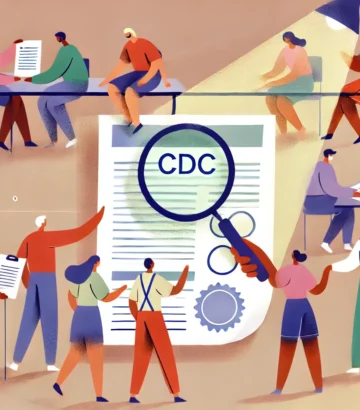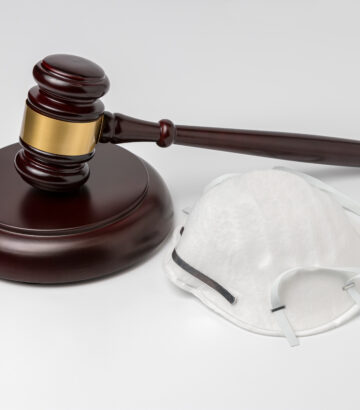IQA Request for Correction: CDC Guidance on Masking, Hand Washing, and COVID-19
October 24, 2024
Subject: IQA Request for Correction: CDC Guidance on Masking, Hand Washing, and COVID-19
From: Yaneer Bar-Yam
To: InfoQuality@cdc.gov
CDC/ATSDR Office of Science Quality
By e-mail: InfoQuality@cdc.gov
Dear Sir/Madam,
I am writing to submit a request for correction under the Information Quality Act (IQA) regarding the consistency and scientific validity of the guidance provided by the Centers for Disease Control and Prevention (CDC).
Specifically, I am requesting an official correction to address the following issue:
The CDC web page titled “COVID-19 can surge throughout the year” [1] was most recently updated on July 3, 2024. This page includes a section titled “Protect Yourself and Others with Practical Actions” followed by an image with the words “Respiratory Virus Guidance Snapshot.” This section identifies “hygiene” and depicts the practice of hand washing, which is known to be of significantly less importance than other measures as a means of preventing COVID-19 infection, as a “Core preventative strategy” to avoid COVID-19 infection. Since SARS-CoV-2 virus particles travel and transmit through aerosols, hand washing should not be listed ahead of more effective prevention measures as a core preventative strategy. This CDC provided information misleadingly implies that handwashing without masking will offer infection prevention from SARS-CoV-2. Since SARS-CoV-2 is an airborne virus, it transmits significantly and primarily through aerosols and not surfaces. [2,3,4,5]
The image notes masking as an “additional preventative strategy.” Since masks, specifically respirators, physically block aerosols and have been shown by many scientific studies to be effective tools against COVID-19 infection and infection from other airborne pathogens, masking (with respirators designed for airborne transmission protection) should be listed as a core preventative strategy. [6,7] In contrast, handwashing provides more limited prevention as it only prevents fomite transmission, while doing nothing to address the transmission through the air. [8]
The scientific literature, from mechanistic analyses to meta analyses, are consistent with the much more limited preventive effect of handwashing than masking for COVID-19 transmission. [9-24] The evidence for handwashing prevention of infection is best for gastrointestinal diseases, with lower efficacy for influenza, and even more limited for COVID prevention across the literature in RCTs and mechanistic studies. Bottlenecks have been identified in limited viable SARS-CoV-2 virus on surfaces, including hands, in real world conditions, a property that can be different from other viruses including those that are airborne [18,19]. The published scientific literature identifies masking, particularly with respirators, as a core preventive strategy for COVID-19, while handwashing is recognized as a valid but supportive measure, grounded in the precautionary principle rather than being a primary preventive strategy. Given the extensive scientific evidence, it is clear that the CDC has not provided comparable scientific justification for promoting handwashing as a core preventive measure for COVID-19, especially in contrast to the well-established efficacy of respirators certified by NIOSH for this purpose.
Indeed, it is apparent, therefore, that the CDC guidance elevating handwashing over masking is not science-based. Further, it should be noted that this guidance exists in multiple places on the CDC’s website and social media accounts.
I recommend revising this section, and all CDC guidance and messaging, to reflect the importance of airborne transmission of COVID-19. Specifically, I recommend that the CDC dedicates less language toward hand washing, which implies SARS-CoV-2 transmits through surfaces, and dedicates more language and emphasis in public communications of all kinds toward science-based guidance which addresses the airborne nature of this virus and its transmission through aerosols. The image depicting handwashing as a core preventative strategy should be updated to reflect the latest scientific guidance on the prevention of airborne transmission of COVID-19, especially effective masking.
All sections of the CDC’s website and social media pages should be audited to feature airborne infection measures as a primary means of infection prevention and control for airborne pathogens. These sections of the site and social media should identify proper airborne infection prevention and control practices, like respirator masking or filtration. CDC’s NIOSH should be able to provide the necessary expertise for this audit.
As a person living in the United States during the ongoing COVID-19 pandemic, I am personally affected by this misleading guidance because it presents outdated and incorrect information to those around me who may become infected with COVID and by infecting others continue spreading it. Further, due to the contagious nature of SARS-CoV-2, any ineffective, incorrect, outdated, or misleading guidance poses significant threat to all people globally.
References:
[1] https://www.cdc.gov/ncird/whats-new/covid-19-can-surge-throughout-the-year.html
[2] https://www.who.int/news-room/questions-and-answers/item/coronavirus-disease-covid-19-how-is-it-transmitted
[3] https://www.thelancet.com/journals/lancet/article/PIIS0140-6736(21)00869-2/fulltext
[4] http://doi.org/10.1126/science.abd9149
[5] Exhibit 1, Analysis and Evidence Supporting a Complaint of Gross Misconduct, https://whn.global/hhs-complaint-on-hicpac/
[6] https://journals.plos.org/plosone/article?id=10.1371/journal.pone.0249891
[7] https://journals.asm.org/doi/full/10.1128/cmr.00124-23
[8] https://www.mdpi.com/1660-4601/20/2/976
Supplementary literature review on hand washing and masking for respiratory infections:
The following studies provide information about the available scientific comparisons of handwashing, as well as masking and handwashing, when using similar methodologies for performing the analysis. There are few studies as the relative importance of airborne transmission has become recognized. Nevertheless, these articles serve as a supplement to studies of masking, especially with respirators, as cited in the text. The overall conclusion of meta analyses of statistical studies is that the evidence for masking as a measure against COVID-19 infection is much stronger than the evidence for handwashing in the same context. Moreover, the scientific studies of transmission and the mechanisms of prevention point to the importance of masking to prevent respiratory transmitted infections, especially of COVID-19, including specific empirical reasons for the limitation of fomite transmission indicated in the literature, specifically the limited ability to obtain viable virus from fomites.
[9] Reported meta analysis on handwashing for respiratory infections not including COVID-19 yields significant but non-statistically significant results (weak 80% confidence interval, instead of standard 95% confidence interval still doesn’t give statistical significance) of 0.97 (80% credible interval 0.92–1.01) per handwashing event. https://www.cambridge.org/core/journals/epidemiology-and-infection/article/effect-of-hand-hygiene-frequency-on-reducing-acute-respiratory-infections-in-the-community-a-metaanalysis/FC28A0855864FBBB33A8AEFBFFF55FC4
[10] Reported meta analysis for handwashing and mask wearing for covid-19 infection reduction: handwashing (significant but non-statistically significant relative risk 0.47, 95% confidence interval 0.19 to 1.12, I2=12%), mask wearing (statistically significant 0.47, 0.29 to 0.75, I2=84%). https://www.bmj.com/content/375/bmj-2021-068302.long
[11] Reported meta analysis for handwashing against influenza or COVID-19 shows inconsistent results among studies https://link.springer.com/article/10.1186/s12889-022-13667-y
[12] Reported meta analysis for handwashing or masking (non respirator) on influenza transmission shows greater effect size of masking than handwashing. Note that 95% statistical significance was not present in these meta analyses) https://www.ncbi.nlm.nih.gov/pmc/articles/PMC7181938/
[13] Limited abstract on meta analysis for handwashing or masking (non respirator): Mask can reduce 0.48 times than not wearing a mask at all, the results are statistically significant (aOR= 0.48; 95% CI= 0.31 to 0.76; p = 0.002) and hand washing can reduce 0.42 times than people who did not wash their hands at all with either soap or hand sanitizer, these results were statistically significant (aOR= 0.42; 95% CI= 0.26 to 0.68; p< 0.001). https://www.thejhpb.com/index.php/thejhpb/article/view/366
[14] Case-control study for COVID-19 shows greater effect from masking than frequent hand washing: Crude odds ratio: Bivariate analysis: 0.41 (95% CI 0.18–0.91) for those who performed handwashing sometimes; 0.19 (95% CI 0.08–0.46) for those who washed hands often; and 0.16 (95% CI 0.07–0.36) for those wearing a mask all the time during contact with a COVID-19 patient. Multivariate analysis: handwashing often (aOR 0.33; 95% CI 0.13–0.87); and wearing a mask all the time during contact with a COVID-19 patient (aOR 0.23; 95% CI 0.09–0.60). https://wwwnc.cdc.gov/eid/article/26/11/20-3003_article
[15] Reported meta analysis of gastrointestinal and respiratory infections (not COVID-19): Improvements in hand hygiene resulted in reductions in gastrointestinal illness of 31% (95% confidence intervals [CI]=19%, 42%) and reductions in respiratory illness of 21% (95% CI=5%, 34%). https://doi.org/10.2105/AJPH.2007.124610
[16] Review of evidence: Current evidence indicates that the risk of infection from fomites is low, and fomites are not likely to be the major transmission pathway for SARS-CoV-2 in most situations. SARS-CoV-2 RNA has been found on environmental surfaces in hospital rooms, quarantine rooms, and other community settings, implying that the surfaces can become contaminated with SARS-CoV-2. Few studies were able to culture live viruses. https://ncceh.ca/resources/evidence-reviews/fomites-and-covid-19-pandemic-evidence-review-its-role-viral
[17] Analysis: Results suggest that the contributions of fomite, droplet, and inhalation transmission without any personal protection to overall risk are 6.9%, 32%, and 61% respectively. With personal protective equipment, the mean percent contributions of fomite, droplet, and inhalation transmission are 2.8%, 30%, and 68% respectively. The use of N95 respirators would further lower the infection risks although the specific percent contributions for each transmission route were not quantified. Whether with or without personal protection, the model suggests that the risk of SARS-CoV-2 infection is much greater through droplet and aerosol transmission than through fomite transmission. https://www.tandfonline.com/doi/full/10.1080/15459624.2020.1784427
[18] Study: Infectious SARS-CoV-2 could be isolated from patient swabs (46.2%). After coughing, no infectious virus could be recovered from steel carriers. Intensive moistening with saliva resulted in successful viral recovery. Transmission of infectious SARS-CoV-2 via fomites is possible upon extensive moistening, but it is unlikely to occur in real-life scenarios and from droplet-contaminated fomites. https://academic.oup.com/jid/article/226/9/1608/6580684
[19] Analysis of evidence: Real life situations are characterized by concentrations of viral particles on fomites that have been shown to have limited or no viable virus. https://www.thelancet.com/journals/laninf/article/PIIS1473-3099(20)30561-2/fulltext
[20] Analysis of evidence: Fomite transmission is an unlikely transmission route for enveloped respiratory viruses such as SARS-CoV-2 (or influenza), due to virus inactivation on human skin. https://www.tandfonline.com/doi/full/10.1080/15459624.2020.1845343
[21] Reported meta analysis on 4 influenza, 1 influenza like, 1 COVID, 1 diarrhea, 1 respiratory and gastrointestinal infections. No statistical significance of washing more than 4 times/day compared to not [odds ratio (OR) =0.61, 95% confidence interval (CI): 0.37 to 1.01]. Case-control studies showed some effect: compared with hand washing ≤4 times/day, hand washing 5–10 times/day (OR =0.75, 95% CI: 0.63 to 0.91) and hand washing >10 times/day (OR =0.65, 95% CI 0.53 to 0.80) could reduce the risk of disease infection. No statistical significance advantage to hand washing more than 10 times/day compared to 5–10 times/day (OR =0.86, 95% CI: 0.70 to 1.06). Comparing hand washing ≤10 times/day with hand washing >10 times/day, increased hand washing was a protective factor against infection (OR =0.59, 95% CI: 0.36 to 0.97). https://www.ncbi.nlm.nih.gov/pmc/articles/PMC8033386/
[22] Study on hand disinfection and mask air filtration: Instant hand wiping using a wet towel soaked in water containing 1.00% soap powder, 0.05% active chlorine, or 0.25% active chlorine from sodium hypochlorite removed 98.36%, 96.62%, and 99.98% of the virus from hands, respectively. N95 masks, medical masks, and homemade masks made of four-layer kitchen paper and one-layer cloth could block 99.98%, 97.14%, and 95.15% of the virus in aerosols. https://onlinelibrary.wiley.com/doi/10.1002/jmv.25805
[23] Meta analysis of masking against COVID: Face mask use could result in a large reduction in risk of infection (n=2647; aOR 0·15, 95% CI 0·07 to 0·34, RD −14·3%, −15·9 to −10·7; low certainty), with stronger associations with N95 or similar respirators compared with disposable surgical masks or similar (eg, reusable 12–16-layer cotton masks; pinteraction=0·090; posterior probability >95%, low certainty). https://www.thelancet.com/journals/lancet/article/PIIS0140-6736(20)31142-9/fulltext
[24] Individual study on the impact of attitudes toward preventive measures: participants who believed that the facemask was important for preventing COVID-19 infection were more likely protected against the disease (OR=0.450; 0.320—0.631). Using a facemask during social visits and shopping indicated a lower protective effect than using it at work (OR=1.299; 1.011—1.668). handwashing time for ≥20 seconds, compared to a shorter time, had a statistically significant protective association with the infection even after adjusting the odds ratio (OR=0.616; 0.4763—0.796). https://doi.org/10.12688/f1000research.129255.1.
Please see below for my personal information:
NAME: Yaneer Bar-Yam
EMAIL ADDRESS: yaneer@necsi.edu
MAILING ADDRESS:
125 Mt. Auburn Street #38031
Cambridge, MA
02238
TELEPHONE NUMBER: ***-***-****
ORGANIZATIONAL AFFILIATION (OPTIONAL): World Health Network (Co-founder)
I request that the CDC thoroughly review and address these concerns in accordance with the Information Quality Act. Specifically, I urge the CDC to:
- provide clear, consistent, and accurate guidance on public health measures, such as mask usage, air filtration and ventilation, regular testing, vaccinating, and avoiding in-person meetings especially in poorly ventilated indoor spaces based on the latest scientific evidence.
- firmly and definitively state and provide adequate, regular messaging about SARS-CoV-2 being an airborne virus
- increase transparency in the decision-making process behind CDC guidance, including the criteria used to evaluate scientific evidence and expert recommendations.
- expedite the incorporation of emerging scientific evidence into CDC guidance to ensure a timely and effective response to public health threats.
I appreciate your attention to these matters and look forward to a prompt and thorough response.
Please acknowledge receipt of this message.
Sincerely,
Yaneer Bar-Yam
Professor and President, New England Complex Systems Institute
Co-founder, World Health Network











